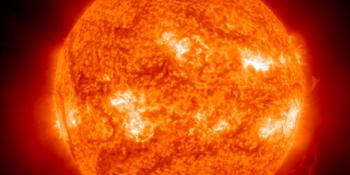Przeglądasz Archiwum z niedziela, 27 marca 2011
Raport aktywności słonecznej
Każdy wspomniany rozbłysk słoneczny w tym raporcie ma współczynnik skalowania dodany przez Space Weather Prediction Center (SWPC). Przez skale współczynników SWPC, raporty o rozbłyskach słonecznych są o 42% mniejsze niż naukowo jakościowa data. Skale współczynników zostały usunięte z naszych archiwów o rozbłyskach słonecznych by odzwierciedlić prawdziwe jednostki fizyczne.
Raport aktywności słoneczno- geomagnetycznej 2011 Mar 27 2200 UTCPrzygotowane przez NOAA © SWPC i przetworzone przez SpaceWeatherLive.com
Połączenie raportów USAF/NOAA o słonecznej i geofizycznej aktywności
Numer SDF 086 wydany w 2200Z na 27 Mar 2011IA. Analiza aktywności regionów słonecznych i aktywność od 26-2100Z do 27-2100Z Solar activity was low. Region 1176 (S15E02) produced a
C3/Sf at 27/0014Z with discrete radio emissions. Associated with
this event was a CME, first observed in LASCO C2 and C3 imagery at
27/0200Z and 27/0242Z respectively. The CME appeared as a narrow
band extending east, as viewed in LASCO, and had an estimated
plane-of-sky velocity of 630 km/s. SDO/AIA 193 imagery indicated
material movement in a wide band extending north through east with
stronger movement in an easterly direction. Region 1176 showed
little change during the period. At 27/0511Z, Type II (estimated
shock velocity of 651 km/s) and Type IV radio signatures were
observed. GOES13 and 15 were in eclipse phase, so GOES XRS data was
not available. At 27/0512Z, limited GOES-15 SXI data indicated
surging and material movement off the NE limb in the vicinity of new
Region 1183 (N15E62). LASCO C2 (27/0536Z) and C3 (27/0606Z) imagery
detected an asymmetric, partial-halo CME lifting off the NE limb
with an estimated plane-of-sky velocity of 880 km/s. New Region 1183
rotated on as a large, 8-spot E-type group with beta-gamma magnetic
characteristics. New Region 1182 (N13E01) evolved on the disk as a
single spot unipolar group. The remaining groups were quiet and
stable during the period. At this time, neither CMEs observed on 27
March appeared to have an Earth-directed component. The Penticton
10.7 cm flux and 90 day mean are estimated due to non-receipt of 27
Marchs flux reading.
IB. Prognoza aktywności słonecznej
Solar activity is expected to be
moderate for the next three days (28-30 March). A chance for M-class
activity exists on day one (28 March) becoming likely on days two
and three (29 - 30 March) with a slight chance for X-class activity
on 29 - 30 March. This expected increase in activity is due to the
complex nature of Regions 1176 and 1183 plus the return of old
Regions 1166 (N10, L=110) on 28 March and 1169 (N17, L=078) on 30
March. On their last transit across the disk, these regions produced
a total of six M-class events and one X-class event.
IIA. Podsumowanie aktywności geofizycznej 26-2100Z do 27-2100Z
The geomagnetic field was quiet. ACE solar wind velocities were low,
varying between 300 to 370 Km/s, while the Bz component of the IMF
was generally north through a majority of the period.
IIB. Prognoza aktywności geofizycznej
The geomagnetic field is
expected to be at quiet to unsettled levels, with isolated active
periods, on day one (28 March) due to possible effects from the 24
March CME. Mostly quiet conditions are expected for day two (29
March). By day three (30 March), quiet to unsettled conditions, with
isolated active periods, are expected due to the arrival of a
recurrent coronal hole high speed stream.
III. Prawdopodobieństwa zdarzenia 28 Mar do 30 Mar
| Klasa M | 50% | 60% | 70% |
| Klasa X | 05% | 10% | 10% |
| Proton | 01% | 01% | 01% |
| PCAF | green | ||
IV. Przepływ 10,7 cm z Penticton
Zaobserwowano 27 Mar 117 Przewidywane 28 Mar-30 Mar 125/125/130 Średnia z 90 dni 27 Mar 097
V. Indeks geomagnetyczny A
Zaobserwowano Afr/Ap 26 Mar 001/001 Szacowane Afr/Ap 27 Mar 001/001 Przewidywane Afr/Ap 28 Mar-30 Mar 010/010-005/005-010/010
VI. Prawdopodobieństwa aktywności geomagnetycznej 28 Mar do 30 Mar
| A. Średnie szerokości geograficzne | |||
|---|---|---|---|
| Aktywne | 20% | 10% | 20% |
| Słaba burza | 05% | 01% | 05% |
| Bardzo znacząca burza | 01% | 01% | 01% |
| B. Wysokie szerokości geograficzne | |||
|---|---|---|---|
| Aktywne | 25% | 15% | 25% |
| Słaba burza | 10% | 01% | 10% |
| Bardzo znacząca burza | 01% | 01% | 01% |
Wszystkie czasy w UTC
<< Idź do codziennego przeglądu
Najnowsze wiadomości
Najnowsze wiadomości z forum
AR 3959 14IP cameras for sky surveillance 41Comet C/2024 G3 (ATLAS) in LASCO C3 10Unspecified geomagnetic activity 1836Filaments and prominences 612
Więcej tematówWesprzyj SpaceWeatherLive.com!
Wielu ludzi odwiedza SpaceWeatherLive aby śledzić aktywność słoneczną lub sprawdzić czy jest szansa na zaobserwowanie zorzy polarnej. Niestety, większy ruch na stronie oznacza większe koszty utrzymania serwera. Dlatego, jeśli jesteś zadowolony ze strony SpaceWeatherLive, zachęcamy do wspierania nas finansowo. Dzięki temu będziemy mogli utrzymać naszą stronę.

Fakty na temat pogody kosmicznej
| Ostatnie rozbłyski klasy X | 2025/01/04 | X1.85 |
| Ostatnie rozbłyski klasy M | 2025/01/09 | M1.1 |
| Ostatnia burza geomagnetyczna | 2025/01/04 | Kp5 (G1) |
| Dni bez plam słonecznych | |
|---|---|
| Ostatni dzień bez skazy | 2022/06/08 |
| Średnia miesięczna liczba plam słonecznych | |
|---|---|
| grudnia 2024 | 154.5 +2 |
| stycznia 2025 | 140.8 -13.8 |
| Ostatnie 30 dni | 151.7 +34.3 |


